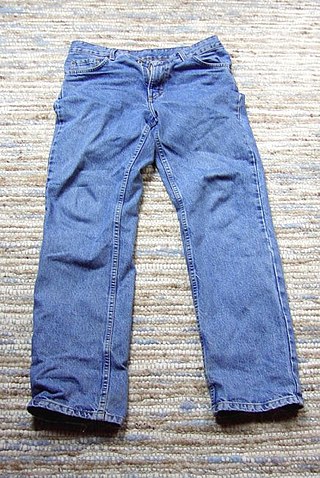
Jeans are a type of trousers made from denim or dungaree cloth. Often the term "jeans" refers to a particular style of trousers, called "blue jeans", with the addition of copper pocket rivets added by Jacob W. Davis in 1871 and patented by Davis and Levi Strauss on May 20, 1873. Prior to the patent, the term "blue jeans" had been long in use for various garments, constructed from blue-colored denim.

Denim is a sturdy cotton warp-faced textile in which the weft passes under two or more warp threads. This twill weave produces a diagonal ribbing that distinguishes it from cotton duck. Denim, as it is recognized today, was first produced in Nîmes, France.
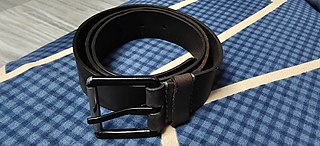
A belt is a flexible band or strap, typically made of leather, plastic, or heavy cloth, worn around the natural waist or near it. The ends of a belt are free; and a buckle forms the belt into a loop by securing one end to another part of the belt, at or near the other end. Often, the resulting loop is smaller than the hips. Belts come in many lengths because of the variety in waist sizes, and most belts can be adjusted at the buckle to suit the wearer's waist.
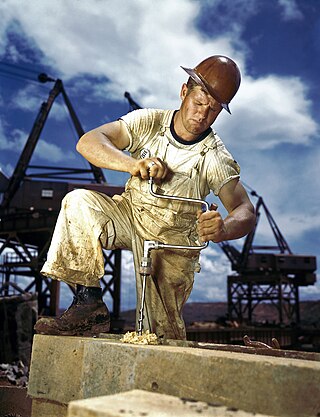
Overalls or bib-and-brace overalls, also called dungarees in British English, are a type of garment usually used as protective clothing when working. The garments are commonly referred to as a "pair of overalls" by analogy with "pair of trousers".

Bell-bottoms are a style of trousers that become wider from the knees downward, forming a bell-like shape of the trouser leg.
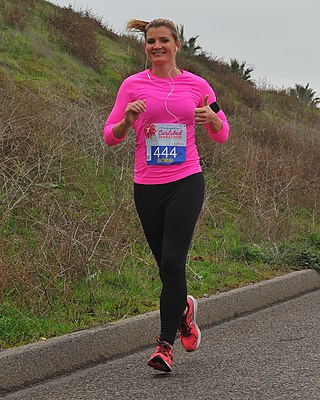
Leggings are several types of leg attire that have varied through the years. Modern usage from the 1960s onwards has come to refer to elastic close-fitting high-rise garments worn over the legs typically by women, such as leg warmers or tights. Usage from the 18th century refers to men's wear usually made of cloth or leather that is wrapped around the leg down to the ankle. In the 19th century, leggings usually referred to infants' leg clothing that were matched with a jacket, as well as leg-wrappings made of leather or wool and worn by soldiers and trappers. Leggings prominently returned to women's fashion in the 1960s, drawing from the form-fitting clothing of dancers. With the widespread adoption of the synthetic fibre Lycra and the rise in popularity of aerobics, leggings came to further prominence in the 1970s and 1980s, and eventually made their way into streetwear. Leggings are a part of the late 2010s into the 2020s athleisure fashion trend of wearing activewear outside sporting activities and in casual settings.
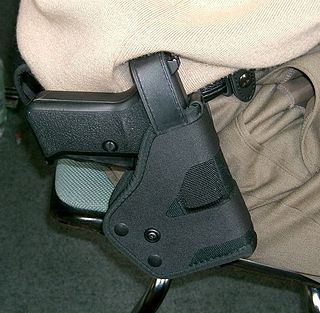
A handgun holster is a device used to hold or restrict the undesired movement of a handgun, most commonly in a location where it can be easily withdrawn for immediate use. Holsters are often attached to a belt or waistband, but they may be attached to other locations of the body. Holsters vary in the degree to which they secure or protect the firearm. Some holsters for law enforcement officers have a strap over the top of the holster to make the handgun less likely to fall out of the holster or harder for another person to grab the gun. Some holsters have a flap over the top to protect the gun from the elements.

Fashion in the 1990s was defined by a return to minimalist fashion, in contrast to the more elaborate and flashy trends of the 1980s. One notable shift was the mainstream adoption of tattoos, body piercings aside from ear piercing and, to a much lesser extent, other forms of body modification such as branding.
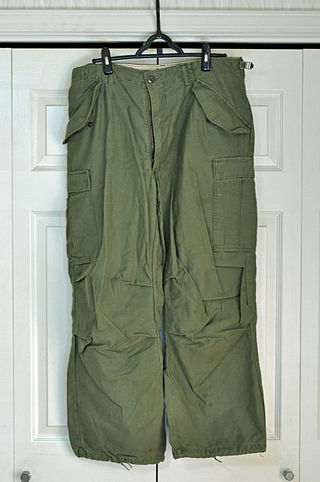
Cargo pants or cargo trousers, also sometimes called combat pants or combat trousers after their original purpose as military workwear, are loosely cut pants originally designed for rough work environments and outdoor activities, distinguished by numerous large utility pockets for carrying tools.
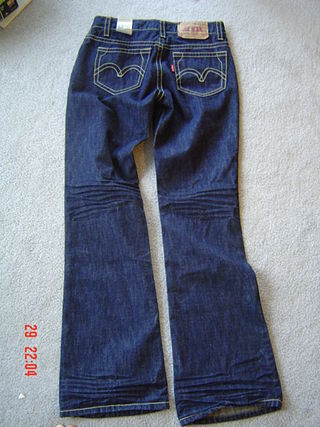
Hip-huggers are pants worn by both men and women, generally made of denim and fitted tightly around the hips and thighs, while usually having flared or bell-bottom lower legs. Hip-huggers were first designed by Irene Kasmer in 1957 in Los Angeles, California. They were worn by the mods in the mid 1960s and into the early 1970s. The late 1970s saw the return of hip-huggers in the disco scene. They were also worn, but to a lesser extent, in the early 1980s, but made a reappearance in the 2000s. The hip-huggers of the 2000s were distinguished by the tightness of the knee, as well as the lower rise of the jeans, typically well below the belly button. This is the product of the boot cut style.

Fashion of the 1980s was characterized by a rejection of 1970s fashion. Punk fashion began as a reaction against both the hippie movement of the past decades and the materialist values of the current decade. The first half of the decade was relatively tame in comparison to the second half, which was when apparel became very bright and vivid in appearance.

The fashions of the 2000s were often described as a global mash up, where trends saw the fusion of vintage styles, global and ethnic clothing, as well as the fashions of numerous music-based subcultures. Hip-hop fashion generally was the most popular among young people of both sexes, followed by the retro-inspired indie look later in the decade.

A denim skirt, sometimes referred to as a 'jean skirt' or 'jeans skirt', is a skirt made of denim, the same material as blue jeans. Denim skirts come in a variety of styles and lengths to suit different populations and occasions. For example, full-length denim skirts are commonly worn by women whose religious beliefs prohibit them from wearing trousers, including Orthodox Jews, some Muslims, Mennonites and Pentecostals, among others. Shorter skirts made of denim are commonly worn by teenagers and young adults.

Fashion in the 1970s was about individuality. In the early 1970s, Vogue proclaimed "There are no rules in the fashion game now" due to overproduction flooding the market with cheap synthetic clothing. Common items included mini skirts, bell-bottoms popularized by hippies, vintage clothing from the 1950s and earlier, and the androgynous glam rock and disco styles that introduced platform shoes, bright colors, glitter, and satin.

Slim-fit pants or skinny jeans are tight trousers that have a snug fit through the legs and end in a small leg opening that can be anywhere from 9" to 20" in circumference, depending on size. Other names for this style include drainpipes, stovepipes, tight pants, cigarette pants, pencil pants, skinny pants, gas pipes, skinnies, and tight jeans.

The Brazilian jiu-jitsu gi is the training uniform adapted from the judo keikogi for use in Brazilian jiu-jitsu. A gi, meaning dress or clothes, is composed of a heavy cotton jacket, reinforced drawstring pants, and a belt which communicates rank. Some schools require the jacket and trousers to be the same color, while more relaxed schools do not enforce matching top and bottom color. The Brazilian jiu-jitsu gi is often referred to as kimono by Brazilians. Some Jiu-Jitsu schools avoid using a gi and instead focus on no-gi jiu-jitsu; 10th Planet Jiu Jitsu is an example of this.

Trousers, slacks, or pants are an item of clothing worn from the waist to anywhere between the knees and the ankles, covering both legs separately. In some parts of the United Kingdom, the word pants is ambiguous: it can mean underpants rather than trousers. Shorts are similar to trousers, but with legs that come down only to around the area of the knee, higher or lower depending on the style of the garment. To distinguish them from shorts, trousers may be called "long trousers" in certain contexts such as school uniform, where tailored shorts may be called "short trousers" in the UK.

Jeggings are leggings that are made to look like skin-tight denim jeans. The word is a portmanteau of the words jeans and leggings.
Disco pants are a type of pants or trousers created in the style of denim jeans and originally made from a combination of nylon and spandex designed to be completely form-fitting with a high shine and high waist.

The clothing style and fashion sense of the Philippines in the modern-day era have been influenced by the indigenous peoples, Chinese waves of immigration, the Spaniards, and the Americans, as evidenced by the chronology of events that occurred in Philippine history. At present, Filipinos conform their way of dressing based on classic fashion or prevailing fashion trends.





















